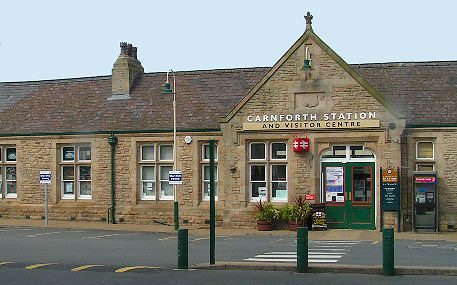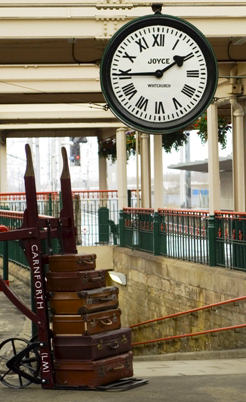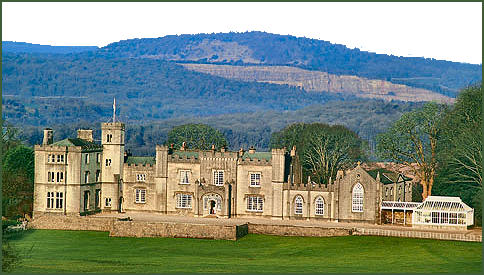Carnforth
OS Grid ref:- SD499704
 The small town of Carnforth lies at the north east end of Morecambe Bay, on the border between Lancashire and Cumbria.
The small town of Carnforth lies at the north east end of Morecambe Bay, on the border between Lancashire and Cumbria.
Carnforth is a popular base for walkers and cyclists exploring the area and is surrounded by superb scenery in an Area of Outstanding Natural Beauty and is also close to the golden sands of Morecambe Bay.
 The town's name is believed to have derived from its old function as a ford of the River Keer on which it lies. Over the centuries, "Keer-ford" may have evolved into the modern Carnforth.
The town's name is believed to have derived from its old function as a ford of the River Keer on which it lies. Over the centuries, "Keer-ford" may have evolved into the modern Carnforth.
During the nineteenth century, Carnforth developed from a small village into a railway town when it became the junction of three major railways. In 1945, Carnforth railway station (pictured right and left) was used as a set for the David Lean film Brief Encounter, starring Celia Johnson and Trevor Howard. Fans of this film were one of the major factors in the recent refurbishment of the railway station, including construction of a refreshment room to match the studio set used in the film, which is now run by the Carnforth Station Trust. Carnforth Station Heritage Centre now covers the fascinating history of Carnforth - its contribution to the World Wars, its important railway history and its families and community.
The town centre features high street shops and cafés, plus a well-established and popular bookshop offering new, classic, second hand and rare books.
 The Lancaster Canal, which runs from Preston to Tewitfield, passes through Carnforth and is now a wildlife haven and a perfect spot for a stroll. Mallards and moorhens, and rarer creatures like kingfishers and water voles may be sighted. There are a number of circular towpath walks, including that to the village of Bolton-le-Sands on the shores of Morecambe Bay. There is an occasional waterbus service along the canal from Carnforth to Tewitfield Locks, a series of eight disused locks which once took boats up 75 feet.
The Lancaster Canal, which runs from Preston to Tewitfield, passes through Carnforth and is now a wildlife haven and a perfect spot for a stroll. Mallards and moorhens, and rarer creatures like kingfishers and water voles may be sighted. There are a number of circular towpath walks, including that to the village of Bolton-le-Sands on the shores of Morecambe Bay. There is an occasional waterbus service along the canal from Carnforth to Tewitfield Locks, a series of eight disused locks which once took boats up 75 feet.
Award winning Leighton Hall (pictured left) is the lived-in house of the famous furniture making Gillow dynasty and is situated to the west of the village of Yealand Conyers, just outside Carnforth. The present Georgian style building was constructed by George Towneley in 1759–61 the architect was John Hird, the woods replanted and park laid out in 1763. The Flying Staircase is an exceptionally fine example of the early Gothic revival, with long dlicate pillars supporting a landing and framing a beautifully curved stone staircase. The family chapel features a fine late eighteenth century Gillow altar front.
The romantic Gothic towers, acres of beautiful gardens and trained birds of prey annually lure thousands of visitors. As well as the house and grounds, with extensive views of the Lakeland Fells, Leighton has a children’s play area and caterpillar maze, plant conservatory and charming tea rooms.
A Walk from Carnforth to Bolton-le-Sands via the Lancaster Canal
Distance :- 4 and a half miles
*Commencing at Carnforth Railway Station, (where parking is provided) proceed to Market Street and then walk along Kellet Road. Just before reacing the canal bridge, turn right passing through a play area to reach the the canal towpath. Turn right and continue passing Carnforth Marina and follow the towpath to Bolton-le-Sands.
*On reaching the canal bridge numbered 122 in the village of Bolton-le-Sands, cross the bridge and leave the canal here, going up St Michael's Lane heading towards the village church.
*Bear left along Bolton Lane, and then turn left onto Mount Pleasant Lane. After the crossroads with Thwaite Brow Lane, the lane becomes a rougher track, continue walking along this track.
*Just before reaching Mount Pleasant, the track bears to the right around some buildings. Continue following the track down to rejoin the canal.
* Cross the canal bridge and turn right along the canal towpath retracing your steps to return to Carnforth Railway Station.
Nearby places of interest
Warton Crag -rising to 163 metres (535 feet) the crag is the highest point in the Arnside and Silverdale Area of Outstanding Natural Beauty (AONB).
Ingleton Waterfalls Trail offers some of the most spectacular waterfall and woodland scenery in the North of England. The trail is 4.5 miles in length and leads through ancient oak woodland and magnificent scenery via a series of stunning waterfalls and geological features.
Lancaster Castle founded in the tenth century
Ashton Memorial in Williamson Park, Lancaster was commissioned by James Williamson, Baron Ashton as a tribute to his second wife, Jenny and was built between 1907 and 1909.
Butterfly House, Lancaster
